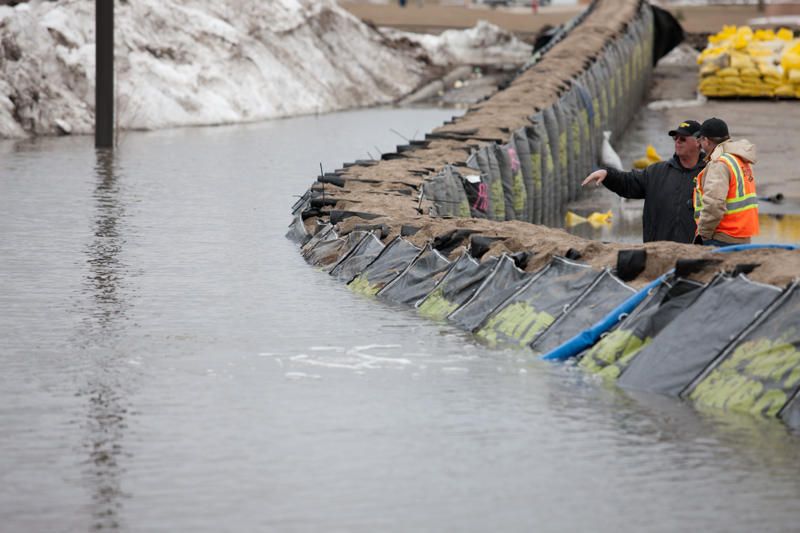TrapBags vs. Flood Bags vs. Bulk Bags for Flood Control
Searching for the most effective form of flood control? TrapBags are the best solution. Learn why TrapBags are superior to water-activated flood barriers.

Floods are dangerous, destructive, and extremely costly—every year, floods cause over $40 billion in damages worldwide. Commercial and residential buildings as well as the environment surrounding them are prone to serious harm when faced with flooding, which is increasing all over the world due to climate change.
It is far more advantageous for people living in flood-prone areas to invest in effective flood control rather than dealing with the high costs and time-consuming efforts of flood restoration. While there are multiple varieties of flood control on the market, TrapBag® barriers offer durable, dependable flood protection for an affordable cost, saving property owners and municipalities money in reparative costs and alleviating stress during and after flooding events.
Types of Flood Control
There are three main kinds of flood control you may have heard of, though they vary greatly in their effectiveness in combating floods.
Flood Bags
Flood bags are water-activated forms of flood control. Due to their interior composition, which is a gel substance, they do not require external fill material, like sand. While this may seem like a simple form of flood protection, flood bags are quite limiting in their protective abilities.
As they are water-activated, flood bags do not begin working until water reaches them, allowing some amount of water to pass over them, making them less effective as a form of flood protection. Due to being individual bags, they are more susceptible to separating in the event of an extreme flood. They are also small in size and would require many stacked upon one another to achieve a height that effectively controls a substantial amount of water.
Bulk Bags
Bulk bags, also known as flexible intermediate bulk containers (FIBC), bulk totes, big bags, super bags, or bulk sacks, are fillable vessels used by many industries for transporting and storing a variety of dry, flowable materials—but not as an effective form of flood control. Bulk bags are not ideal for flood protection for a few reasons. They are very large, often requiring a skid loader to place and a significant amount of fill to stand upright. They are individual bags that could easily allow water to pass through gaps, and they are not inherently waterproof—a separate waterproof membrane must be added to the bulk bag to ensure water doesn’t pass by.
TrapBags
TrapBag barriers are an engineered form of flood control, designed as the ultimate method of easy, affordable flood protection for all kinds of industries and infrastructure. TrapBags are fillable bags made of an extremely strong geotextile material with an interconnected accordion structure, making them both simple to rapidly deploy and also extremely effective at preventing leaks during a flood, unlike flood bags and bulk bags.
While standard flood bags are only two feet tall, requiring many for stacking if water levels continue to rise, TrapBags are double the height. For reference, a single 100-ft section of TrapBags replaces around 8,000 sandbags, saving deployment teams time and money in materials.
Unlike many forms of flood control, TrapBags can be used as a temporary or permanent flood solution, depending on the type of fill utilized. When filled with sand or washed gravel, TrapBags can be used as effective emergency flood control, or they can stand as permanent flood barriers, ideal for coastal cities or lakeshores prone to flooding.
Why Water-Activated Flood Bags Aren’t the Best
If you’ve never used flood protection before, you may think that water-activated flood bags are the best form of flood control. They are not, however; sandless flood bags do not start properly working to hold back flood waters until water reaches them, whereas TrapBag barriers can be filled and quickly placed prior to a flooding event, diverting water instantly and preventing any spillover.
Water-absorbing flood bags can only hold limited amounts of water, as opposed to TrapBags, which redirect flood waters for as long as they are battering the land. TrapBags are a much more effective and suitable solution for serious flood protection.
Industries Switching from Flood Bags to TrapBag
Due to their versatility and durability, many industries are making the switch from bulk bags and flood bags to TrapBag for all flood prevention needs.
Agricultural Flood Control
Whether you’re near an overflowing body of water or experiencing flash flooding, extreme amounts of water can be devastating in an agricultural environment, destroying soil, drowning crops, and depositing harmful, hard-to-clear debris.
More and more farmers are finding out why TrapBags are considered the industry standard in flood control. TrapBag barriers can be used to divert flooding away from farmland and crops, saving farmers immense amounts of money in losses every year. A levee or dike constructed of TrapBags gives peace of mind before and during flood events.
Construction Flood Prevention
When undergoing commercial or residential construction, sticking to a timeline and budget is incredibly important. Improper construction flood protection can upend any regimented plans as large amounts of water delay construction. As standard construction bulk bags are not watertight, TrapBags are the way to go.
TrapBags can be used during the construction process to help with flood prevention by diverting water to take a safer, less damaging route, ensuring the project stays on track even after an unexpected bout of bad weather. Trapbags can also be used in water construction, acting as cofferdams to allow the crew to continue time-sensitive work on dry ground.
Flood Water Diversion for Disaster Relief
In times of extreme inclement weather, from a tsunami, hurricane, or mudslide, TrapBags can be used for disaster relief instead of FIBC bulk bags. TrapBags provide a steady barrier in instances of flooding or levee breaches, saving surrounding property and people from submersion.
Other Uses for TrapBag
TrapBags are versatile solutions to other problems commercial property owners or municipalities may face.
Erosion Control
Erosion is a natural phenomenon exacerbated by unnatural industrial activity that is leading to climate change and more severe natural disasters. Erosion control is important to preserving the world around us, and when it comes to dependable protection, TrapBags are a clear choice.
The erosion of environmentally-important natural features like sand dunes, riverbanks, and steep slopes is greatly minimized when TrapBags are in place. As they are able to be filled with sand, washed gravel, or concrete, when used as erosion control bags, TrapBags can function as both temporary and permanent barriers to corroding earth.
Stormwater Containment
Polluted stormwater poses a threat to the surrounding ecosystems. On certain job sites with potential pollutants and debris, like in construction, it is the responsibility of the crew to enact proper stormwater containment facilities. TrapBags can be used to create a designated basin for the stormwater to run into, keeping the nearby land and water sources safe.
Spill Control
If you’re in an environment working with large amounts of chemicals or oils and experience a spill, you are required by law to deal with the spill in a quick, effective manner. TrapBags are a great temporary solution to time-sensitive spill control scenarios, maintaining durability while a cleanup operation is organized.
Switch to TrapBag, the Superior Flood Bag
No matter your industry or flood protection needs, TrapBag barriers can provide a variety of reliable solutions to protect environments and structures from flooding, saving your company and municipality money. Send us a message today to learn more about utilizing TrapBag barriers.
Meet the author
Get the Dirt Before the Flood Hits
Stay ahead of flooding, erosion, and disaster response challenges. The Dirt, TrapBag’s monthly newsletter, delivers field-tested tips, real-world case studies, and the latest in barrier technology straight to your inbox.

